The Classification of Cultural Heritage Buildings in Athens Using Deep Learning Techniques
Abstract
1. Introduction
2. Deep Learning and the Yolo Algorithm
3. Related Work
3.1. Non-Deep Learning Architectural Style Identification
3.2. Deep Learning Architectural Style Identification
4. Methodology
4.1. The Architectural Styles of Athenian Houses (after 1834)
- Neoclassical architecture:This style, which emerged in Europe in the 18th century, is characterized by plasticity, harmony in volumes, and elaborate decoration. It is often associated with the classical Greek and Roman styles. The capital of the early 19th century adopted this style as a reference to its ancient past. One of the key features of neoclassical architecture is its use of classical motifs and elements so as to create a sense of order and grandeur [54]. The characteristics of the Athenian neoclassical style were symmetrical and balanced design, with a focus on clean lines and geometric shapes; decoration with columns and pilasters, pediments, and friezes; balconies with corbels; railings with elaborate designs; etc. [23]. In the first period, which dates to the reign of Otto, many Bavarian engineers, craftsmen, and German architects arrived in the country, and their works influenced the Greek engineers and craftsmen. Until the late 19th century, the architects Stamatis Kleanthis, Panagis Kalkos, Friedrich Wilhelm von Gartner, the Hansen brothers, and Lysandros Kavtatzoglou were active, while in the late 19th and early 20th centuries, Ernst Ziller was responsible for the construction of hundreds of public and private buildings [55].
- Eclecticism:This is a decorative and ornamental style that emerged in Athens in the late 19th and early 20th centuries (influenced by Art Nouveau, Viennese secession, the École des Beaux-Arts, etc.). It refers to the use of a variety of different styles and elements from different time periods and places in the design of a building or structure. This approach allows architects to create designs that incorporate elements from various historical styles, such as classicism, Baroque, etc. It is characterized by the excessive use of decorative elements, the use of organic and floral motifs, curved lines, and natural forms, as well as the use of modern materials such as steel and glass [23]. The main exponents of Greek eclecticism were Aristotle Zachos, who tried to combine eclecticism with German modernism, as well as Byzantine or neo-Byzantine elements; Vasilios Kouremenos, who used elements of the Parisian Beaux-Arts; Emmanouil Lazaridis; Vasileios Tsagris; and Sοtirios Mayasis, who tried to express Art Nouveau in an eclectic way [56].
- Interwar architecture:This style emerged in the early 20th century, during the period between the end of World War I and the beginning of World War II (in Athens, after the catastrophe of Asia Minor in 1922). It is characterized by its emphasis on simplicity, functionality, and a lack of ornamentation [22]. It was actually a shift away from the ornate and grandiose styles of the 19th century towards more practical designs. It is often associated with the International Style and Bauhaus movements, which focused on minimalist designs that prioritized form and function over decorative elements. Its characteristics are the use of new materials such as iron and concrete, the polygonal structures, bay windows, artificial coatings, etc. Nikolaos Mitsakis, Kyriakoulis Panagiotakos, Patroklos Karantinos, Vasilios Douras, Georgios Kontoleon, and Polyvios Michaelidis are some of the important representatives of the architectural generation of the 1930s—the generation of the Modern Movement [57].
- Postwar architecture:Postwar architecture in Athens is characterized by concrete multistory apartment buildings that became the trademark of the city. This style emerged in the aftermath of World War II, as the city sought to expand and modernize in the face of significant internal migration from the rural areas to the capital [58]. The multistory apartment building (polykatoikia) typically consists of a number of units stacked on top of each other and is a common building type in the urban areas of Athens. On the ground floors, the building’s use is often commercial, while the upper floors house apartments and offices [59]. From the war onwards, anonymous architecture dominates in Athens, without any distinguished major representatives of the time. This fact does not mean that in the years that followed there were no important architects who worked and produced great architecture, but the architects of that period did not exert a wider influence on the mass construction of the building stock of the Greek capital.
4.2. Data Set
4.3. The YOLO Training
4.3.1. Training Phase 1: Identifying Doors, Windows, Balconies, Corbels
4.3.2. Training Phase 2: Identifying Neoclassical, Interwar, and Postwar Buildings
4.3.3. Training Phase 3: Identifying Neoclassical, Interwar, Postwar, Neoclassical-Eclectic, and Interwar-Eclectic Buildings
5. Study Cases for Generalization Assessment
6. Discussion of the Results
- with buildings with changed use (e.g., the ground floor had been converted into a commercial shop, so the original dimensions of the openings were now altered and signs had been placed);
- with severe occlusions of the buildings (e.g., from trees, signs, vehicles, etc.);
- where buildings appeared in bad condition (they showed damage or interventions, e.g., graffiti, or they were abandoned or in a dilapidated state);
- where postwar buildings were constructed with morphological elements that referred to a previous historical period.
- (1)
- In each validation process there was always a relatively small but noteworthy number of photos for which the algorithm could not make a prediction at all;
- (2)
- In some cases, photographs of the same building from different angles or shot at different time periods or in different illumination conditions were classified in different classes (Figure 19);
- (3)
- The transitional periods of the neoclassical-eclectic and the interwar-eclectic classes present the lowest prediction scores. On the contrary, the classes of neoclassical, interwar, and apartment buildings, which appear to have more distinctive characteristics, are more easy to classify.
7. Conclusions
- The classification of buildings’ typologies is an extremely complex issue, especially when it comes to the study of characteristics that change over time, due to their possibly different construction phases and different architectural interventions;
- There is a strong need to limit through modeling the variables that describe the evolution and change of building typology in order to evaluate the importance of AI in comparison to manual methods;
- The imperative need for a multidisciplinary approach and research that requires the development of new methodologies, multicriteria models, and tools, and that requires cooperation and the convergence of the expertise of researchers from different scientific disciplines (an interdisciplinary and transdisciplinary approach) is not disputed;
- The recent literature highlights the importance of new technologies, and especially information technology, as a catalyst for the development of research in the specific cognitive area of culture, and the acceleration and promotion of research with new original methods is considered imperative today.
Author Contributions
Funding
Data Availability Statement
Acknowledgments
Conflicts of Interest
References
- Sun, M.; Zhang, F.; Duarte, F.; Ratti, C. Understanding architecture age and style through deep learning. Cities 2022, 128, 103787. [Google Scholar] [CrossRef]
- Kremmyda, A.; Siountri, K.; Anagnostopoulos, I. Vra Core 4.0 Metadata Standard for the Facades of the Historic Houses of Athens (19th–Early 20th Century). In TMM_CH 2021: Trandisciplinary Multispectral Modelling and Cooperation for the Preservation of Cultural Heritage; Moropoulou, A., Georgopoulos, A., Doulamis, A., Ioannides, M., Ronchi, A., Eds.; Springer: Cham, Switzerland, 2022; pp. 66–78. [Google Scholar]
- Chaidas, K.; Tataris, G.; Soulakellis, N. Post-earthquake 3D building model (LOD2) generation from UAS imagery: The case of Vrisa traditional settlement, Lesvos, Greece. Int. Arch. Photogramm. Remote Sens. Spat. Inf. Sci. 2020, 44, 165–172. [Google Scholar] [CrossRef]
- Triantafylopoulos, N. Preserved Buildings: The Legal and Economic Basis of the Obligation to Provide State aid for Their Restoration and Reuse, Research Series, TMXPPA-PH. 2017, 23, 89–120. Available online: https://pithos.okeanos.grnet.gr/public/rFxt4KcVH0vXmjicOiSlK6 (accessed on 15 January 2023).
- A Renovation Wave for Europe—Greening our Buildings, Creating Jobs, Improving Lives (2020). Available online: https://eur-lex.europa.eu/legal-content/EN/TXT/?qid=1603122220757&uri=CELEX:52020DC0662 (accessed on 15 January 2023).
- New European Bauhaus, (2021). Available online: https://europa.eu/new-european-bauhaus/about/about-initiative_en (accessed on 15 January 2023).
- Foster, G. Circular economy strategies for adaptive reuse of cultural heritage buildings to reduce environmental impacts. Resour. Conserv. Recycl. 2020, 152, 104507. [Google Scholar] [CrossRef]
- Pendlebury, J.; Mark, S.; Loes, V.; Wout van der Toorn, V.; Declan, R. After the Crash: The Conservation-Planning Assemblage in an Era of Austerity. Eur. Plan. Stud. 2020, 28, 672–690. [Google Scholar] [CrossRef]
- Veldpaus, L.; Pendlebury, J. Heritage as a Vehicle for Development: The Case of Bigg Market, Newcastle upon Tyne. Plan. Pract. Res. 2019, 1–15. [Google Scholar] [CrossRef]
- Ginzarly, P.; Roders, A.; Teller, J. Mapping historic urban landscape values through social media. J. Cult. Herit. 2019, 36, 1–11. [Google Scholar] [CrossRef]
- Vassi, A.; Siountri, K.; Papadaki, K.; Iliadi, A.; Ypsilanti, A.; Bakogiannis, E. The Greek Urban Policy Reform through the Local Urban Plans (LUPs) and the Special Urban Plans (SUPs), Funded by Recovery and Resilience Facility (RRF). Land 2022, 11, 1231. [Google Scholar] [CrossRef]
- A European Green Deal (2020). Available online: https://commission.europa.eu/strategy-and-policy/priorities-2019-2024/european-green-deal_el (accessed on 15 March 2023).
- Buildings Inventory, (2011), Greek Statistical Authority. Available online: https://www.statistics.gr/el/2021-buildings-census (accessed on 15 January 2023).
- Archaeological Land Register. Available online: https://www.arxaiologikoktimatologio.gov.gr/ (accessed on 15 January 2023).
- Archive of Traditional Settlements and Listed Buildings. Available online: http://estia.minenv.gr/ (accessed on 15 January 2023).
- Available online: https://www.monumenta.org/article.php?IssueID=4&perm=1&ArticleID=1024&CategoryID=23&lang=gr (accessed on 15 January 2023).
- ModMovAthens. Available online: https://www.kolofotias.com/portfolio/mod-mov-athens/ (accessed on 15 January 2023).
- Listed Buildings Archive. Available online: https://diathrhtea.blogspot.com/?fbclid=IwAR3vNDbVKJgQOrEQ_CjlgEHJ8BA4QgFfJKcbWIzCnUPi8kUGsYkHQmC7cdo (accessed on 15 January 2023).
- Interesting Architecture of Athens. Available online: http://www.zee.gr/architecture/ (accessed on 15 January 2023).
- Summerson, J. The Classical Language of Architecture; The MIT Press: Cambridge, MA, USA, 1992. [Google Scholar]
- Balafoutis, T.; Zerefos, S. A database of architectural details: The case of neoclassical façades elements. In Proceedings of the International Conference—BRAU4, Biennial of Architectural and Urban Restoration, Athens, Greece, 15–30 April 2018; pp. 15–30. [Google Scholar]
- Katsibokis, G. Ktiriothiki: The architectural heritage of Athens, 1830–1950. J. Mod. Greek Stud. 2013, 31, 133–149. [Google Scholar] [CrossRef]
- Biris, M. Athinaiki Arhitektoniki 1875–1925 [Athenian Architecture 1875–1925]; Melissa: Athens, Greece, 2003. [Google Scholar]
- Vaiou, D. Milestones in the urban history of Athens. Treb. De La Soc. Catalana De Geogr. 2002, 53, 209–226. [Google Scholar]
- McCulloch, W.S.; Pitts, W. A logical calculus of the ideas immanent in nervous activity. Bull. Math. Biophys. 1943, 5, 115–133. [Google Scholar] [CrossRef]
- Voulodimos, A.; Doulamis, N.; Doulamis, A.; Protopapadakis, E. Deep Learning for Computer Vision: A Brief Review. Comput. Intell. Neurosci. 2018, 2018, 7068349. [Google Scholar] [CrossRef] [PubMed]
- Deng, L. Artificial intelligence in the rising wave of deep learning: The historical path and future outlook [perspectives]. IEEE Signal. Process. Mag. 2018, 35, 177–180. [Google Scholar] [CrossRef]
- Feldman, M. 10 Real-World Examples of Machine Learning and AI. 2018. Available online: https://omdena.com/blog/machine-learning-examples/ (accessed on 15 January 2023).
- Redmon, J.; Divvala, S.; Girshick, R.; Farhadi, A. You look only once: Unified real-time object detection. arXiv 2015, arXiv:1506.02640. [Google Scholar]
- Li, M.; Zhang, Z.; Lei, L.; Wang, X.; Guo, X. Agricultural greenhouses detection in high-resolution satellite images based on convolutional neural networks: Comparison of faster R-CNN, YOLO v3 and SSD. Sensors 2020, 20, 4938. [Google Scholar] [CrossRef] [PubMed]
- Girshick, R.; Donahue, J.; Darrell, T.; Malik, J. Rich Feature Hierarchies for Accurate Object Detection and Semantic Segmentation. In Proceedings of the 2014 IEEE Conference on Computer Vision and Pattern Recognition, Columbus, OH, USA, 23–28 June 2014; pp. 580–587. [Google Scholar] [CrossRef]
- Ren, S.; He, K.; Girshick, R.B.; Sun, J. Faster R-CNN: Towards Real-Time Object Detection with Region Proposal Networks. IEEE Trans. Pattern Anal. Mach. Intell. 2015, 39, 1137–1149. [Google Scholar] [CrossRef]
- Redmon, J.A.; Farhadi, A. YOLO9000: Better, Faster, Stronger. In Proceedings of the 2017 IEEE Conference on Computer Vision and Pattern Recognition (CVPR), Honolulu, HI, USA, 21–26 July 2017; pp. 6517–6525. [Google Scholar] [CrossRef]
- Bochkovskiy, A.; Wang, C.; Liao, H.M. YOLOv4: Optimal Speed and Accuracy of Object Detection. arXiv 2020, arXiv:2004.10934. [Google Scholar]
- Redmon, J.; Farhadi, A. Yolov3: An incremental improvement. arXiv 2018, arXiv:1804.02767. [Google Scholar]
- Xue, J.; Zheng, Y.; Dong-Ye, C.; Wang, P.; Yasir, M. Improved YOLOv5 network method for remote sensing image-based ground objects recognition. Soft Comput. 2022, 26, 10879–10889. [Google Scholar] [CrossRef]
- Kioussi, A.; Karoglou, M.; Protopapadakis, E.; Doulamis, A.; Ksinopoulou, E.; Bakolas, A.; Moropoulou, A. A computationally assisted cultural heritage conservation method. J. Cult. Herit. 2021, 48, 119–128. [Google Scholar] [CrossRef]
- Mathias, M.; Martinovic, A.; Weissenberg, J.; Haegler, S.; Van Gool, L. Automatic architectural style recognition. ISPRS-Int. Arch. Photogramm. Remote Sens. Spat. Inf. Sci. 2011, 3816, 171–176. [Google Scholar] [CrossRef]
- Shalunts, G.; Haxhimusa, Y.; Sablatnig, R. Architectural style classification of building facade windows. In International Symposium on Visual Computing; Springer: Berlin/Heidelberg, Germany, 2011; pp. 280–289. [Google Scholar]
- Shalunts, G.; Haxhimusa, Y.; Sablatnig, R. Classification of gothic and baroque architectural elements. In Proceedings of the 19th International Conference on Systems, Signals and Image Processing (IWSSIP), Vienna, Austria, 11–13 April 2012; IEEE: New York, NY, USA, 2012; pp. 316–319. [Google Scholar]
- Shalunts, G.; Cerman, M.; Albertini, D. Detection of sculpted faces on building facades. In Proceedings of the Asia-Pacific Signal. and Information Processing Association Annual Summit and Conference (APSIPA ASC), Kuala Lumpur, Malaysia, 12–15 December 2017; IEEE: New York, NY, USA, 2017; pp. 677–685. [Google Scholar]
- Mercioni, M.A.; Holban, S. The recognition of the architectural style using Data Mining techniques. In Proceedings of the IEEE 12th International Symposium on Applied Computational Intelligence and Informatics (SACI), Timisoara, Romania, 17–19 May 2018; IEEE: New York, NY, USA, 2018; pp. 000331–000338. [Google Scholar]
- Llamas, J.; Lerones, P.M.; Zalama, E.; Gómez-García-Bermejo, J. Applying deep learning techniques to cultural heritage images within the inception project. In Digital Heritage. Progress in Cultural Heritage: Documentation, Preservation, and Protection, Proceedings of the Euro-Mediterranean Conference, Nicosia, Cyprus, 31 October–5 November 2016; Springer: Cham, Switzerland, 2016; pp. 25–32. [Google Scholar]
- Schmitz, M.; Mayer, H. A convolutional network for semantic facade segmentation and interpretation. Int. Arch. Photogramm. Remote. Sens. Spat. Inf. Sci. 2016, 41, 709. [Google Scholar] [CrossRef]
- Pesto, C. Classifying US Houses by Architectural Style Using Convolutional Neural Networks. 2017. Available online: http://cs231n.stanford.edu/reports/2017/pdfs/126.pdf (accessed on 15 January 2023).
- Guo, K.; Li, N. Research on classification of architectural style image based on new cognitive area network. In Proceedings of the IEEE 3rd Information Technology and Mechatronics Engineering Conference (ITOEC), Chongqing, China, 3–5 October 2017; IEEE: New York, NY, USA, 2017; pp. 1062–1066. [Google Scholar]
- Laupheimer, D.; Haala, N. Deep Learning for the Classification of Building Facades, Publikationen der DGPF, Band 27, 2018, pp. 701–709. Available online: https://www.dgpf.de/src/tagung/jt2018/proceedings/proceedings/papers/28_PFGK18_KKN_01_Laupheimer_Haala.pdf (accessed on 15 January 2023).
- Li, Y.; Chen, Y.; Rajabifard, A.; Khoshelham, K.; Aleksandrov, M. Estimating building age from Google Street View images using deep learning (short paper). In Proceedings of the 10th International Conference on Geographic Information Science (GIScience), Melbourne, Australia, 28–31 August 2018; Schloss Dagstuhl-Leibniz-Zentrum fuer Informatik: Wadern, Germany, 2018. [Google Scholar]
- Zou, Z.; Zhao, X.; Zhao, P.; Qi, F.; Wang, N. CNN-based statistics and location estimation of missing components in routine inspection of historic buildings. J. Cult. Herit. 2019, 38, 221–230. [Google Scholar] [CrossRef]
- Dautov, E.; Astafeva, N. Convolutional Neural Network in the Classification of Architectural Styles of Buildings. In Proceedings of the IEEE Conference of Russian Young Researchers in Electrical and Electronic Engineering (ElConRus), St. Petersburg, Russia, 26–29 January 2021; IEEE: New York, NY, USA, 2021; pp. 274–277. [Google Scholar]
- Ji, S.Y.; Jun, H.J. Deep learning model for form recognition and structural member classification of east asian traditional buildings. Sustainability 2020, 12, 5292. [Google Scholar] [CrossRef]
- Kioussi, A.; Doulamis, A.; Karoglou, M.; Moropoulou, A.I. Cultural Intelligence-Investigation of Different Systems for Heritage Sustainable Preservation. Int. J. Art Cult. Des. Technol. (IJACDT) 2020, 9, 15. [Google Scholar] [CrossRef]
- Kallibretakis, L Athens in the 19th Century: From a Provincial City of the Ottoman Empire to the Capital of the Hellenic Kingdom. Available online: https://archaeologia.eie.gr/archaeologia/gr/chapter_more_9.aspx (accessed on 15 January 2023).
- Mpirēs, M.G.; Birēs, M.G.; Kardamitsi-Adami, M.; Kardamitsē-Adamē, M. Neoclassical Architecture in Greece; Getty Publications: Los Angeles, CA, USA, 2004. [Google Scholar]
- Kydoniatis, S. Greek Architectural Renaissance and Its Maltreatment; The Academy of Athens Press: Athina, Athens, 1980. [Google Scholar]
- Lavvas, G. A Brief History of Architecture with an Emphasis on the 19th and 20th Centuries; University Studio Press: Thessaloniki, Greece, 2008. [Google Scholar]
- Athanassiou, E.; Dima, V.; Karali, K.; Belli, G.; Capano, F.; Pascariello, M.I. Modern Architectural Encounters and Greek Antiquity in the Thirties. In La Citta, Il Viaggio, Il Tourismo: Percezione, Produzione e Transformazione. The City, the Travel, the Tourism: Perception, Production and Processing; FedOA-Federico II University Press: Naples, Italy, 2017; pp. 347–354. Available online: https://scholar.google.com/scholar?hl=el&as_sdt=0%2C5&q=Athanassiou%2C+E.%3B+Dima%2C+V.%3B+Karali%2C+K.%3B+Belli%2C+G.%3B+Capano%2C+F.%3B+Pascariello%2C+M.I.+Modern+architectural+encounters+and+Greek+an-tiquity+in+the+thirties.+In+La+Citta%2C+Il+Viaggio% (accessed on 15 January 2023).
- Fessas–Emmanouil, H. The Role and Work of Architects in Athens in the Second Half of the 20th Century: A Brief Outline. In BALKAN CAPITALS from the 19th to the 21st Century; p. 90. Available online: https://d1wqtxts1xzle7.cloudfront.net/53017870/BALKAN_CAPITALS_edu-libre.pdf?1494058447=&response-content-disposition=inline%3B+filename%3DBALKAN_CAPITALS_FROM_THE_19th_TO_THE_21s.pdf&Expires=1681296277&Signature=Dq7wlRXhf~C-qB~~Dk2lVyZY8l4i~zPSF20v0DhKGUjzPGO1OfGMENu-14k~hoWY37tbVC0PDSJGz-AOcs2HTQ7Tg3wafTi0hloaZ909rzU4fuSyk5clUM5OGOQN1~JiEIu1S5ENj9Gmg8Z0ZbsnPEwjP2HyECc743i3zQNBuwQ1WyL5JTp7RdmkuTz7mt4ZoxZJDFXU~ic81BGCqAAX9FZQSzITIUwjQ2LD~0WVh841DJmbf~A3wrwBMr52YctZGiSOzYYyFcAV3Mr3J8u7ed-21dSoltFOjSstgwU~0xSZdkeJB-9CnWvItExqi0gg8OeCL4Vj1OGqu1TXUmxd5A__&Key-Pair-Id=APKAJLOHF5GGSLRBV4ZA#page=91 (accessed on 15 January 2023).
- Woditsch, R. Τhe Public Private House: Modern and Its Polykatoikia; Park. Books: Zurich, Switzerland, 2018. [Google Scholar]
- Filippides, D. 1984 Neo-Hellenic Architecture; Melissa: Athens, Greece, 2003. [Google Scholar]
- Ćosović, M.; Janković, R. CNN Classification of the Cultural Heritage Images. In Proceedings of the 2020 19th International Symposium INFOTEH-JAHORINA (INFOTEH), East Sarajevo, Bosnia and Herzegovina, 18–20 March 2020; IEEE: New York, NY, USA, 2020; pp. 1–6. [Google Scholar] [CrossRef]
- Laroca, R.; Severo, E.; Zanlorensi, L.A.; Oliveira, L.S.; Gonçalves, G.R.; Schwartz, W.R.; Menotti, D. A robust real-time automatic license plate recognition based on the YOLO detector. In Proceedings of the International Joint Conference on Neural Networks (IJCNN), Rio de Janeiro, Brazil, 8–13 July 2018; IEEE: New York, NY, USA, 2018; pp. 1–10. [Google Scholar]
- Available online: https://github.com/AlexeyAB/darknet (accessed on 10 December 2020).
- Palaiologou, G.; Fouseki, K. New Perspectives in Urban Heritage—Theory, Policy and Practice. Hist. Environ. Policy Pract. 2018, 9, 175–179. [Google Scholar] [CrossRef]
- Skondras, E.; Siountri, K.; Michalas, A.; Vergados, D.D. A route selection scheme for supporting virtual tours in sites with cultural interest using drones. In Proceedings of the 2018 9th International Conference on Information, Intelligence, Systems and Applications (IISA), Zakynthos, Greece, 23–25 July 2018; IEEE: New York, NY, USA, 2018; pp. 1–6. [Google Scholar]
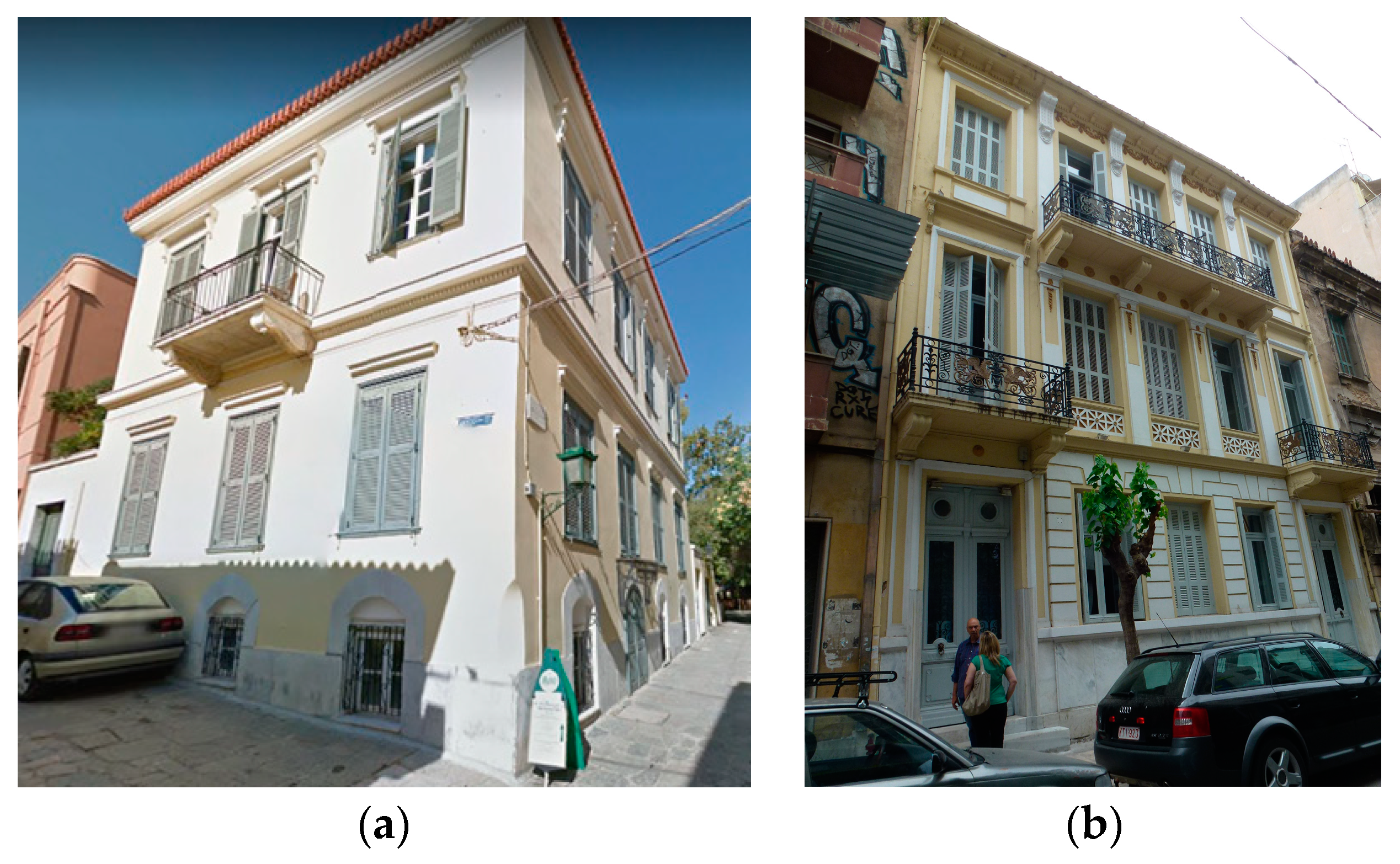
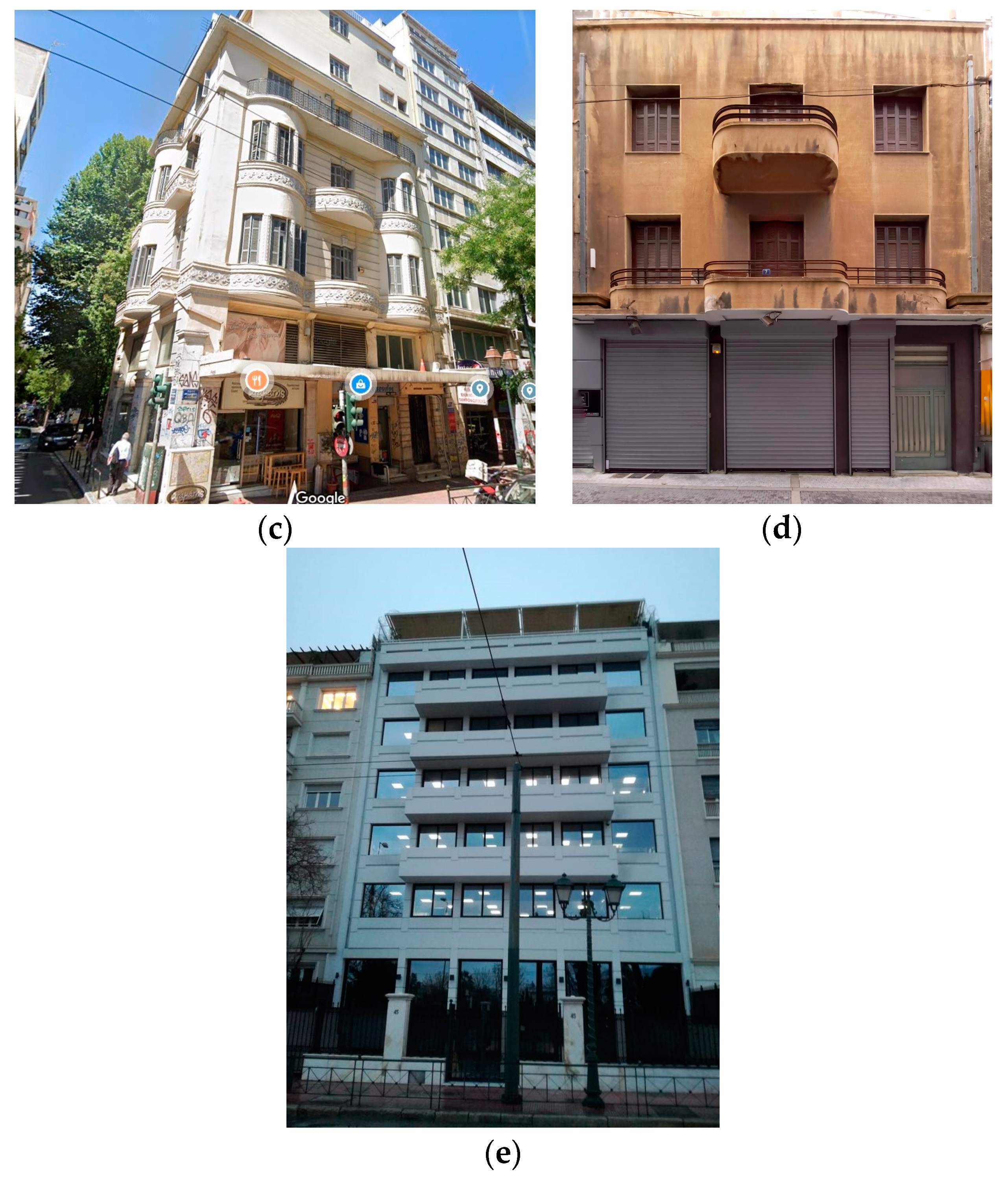
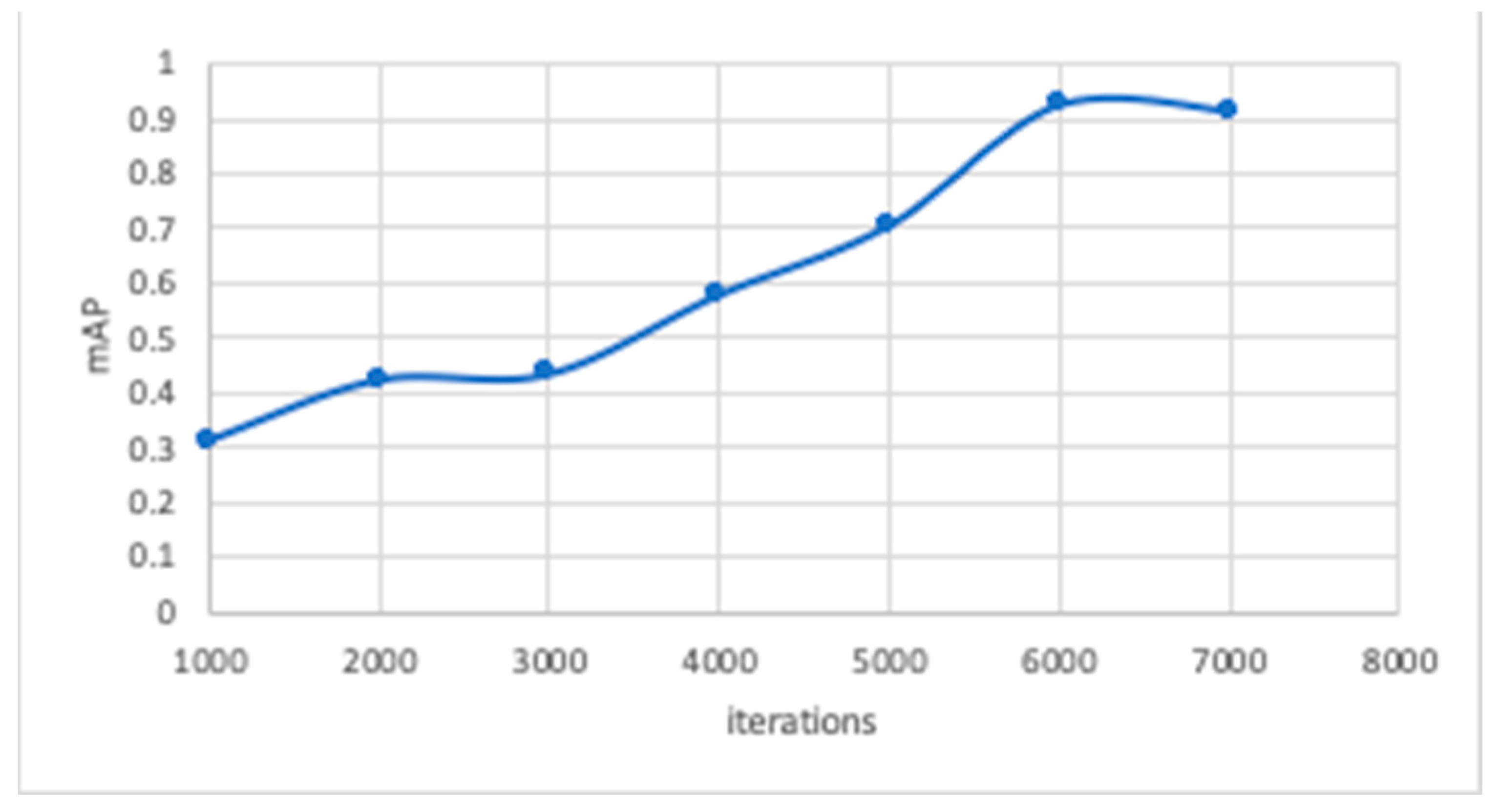

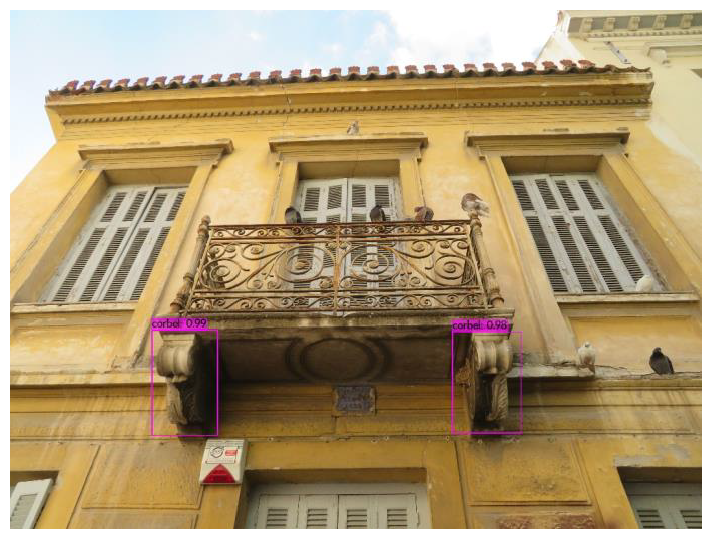

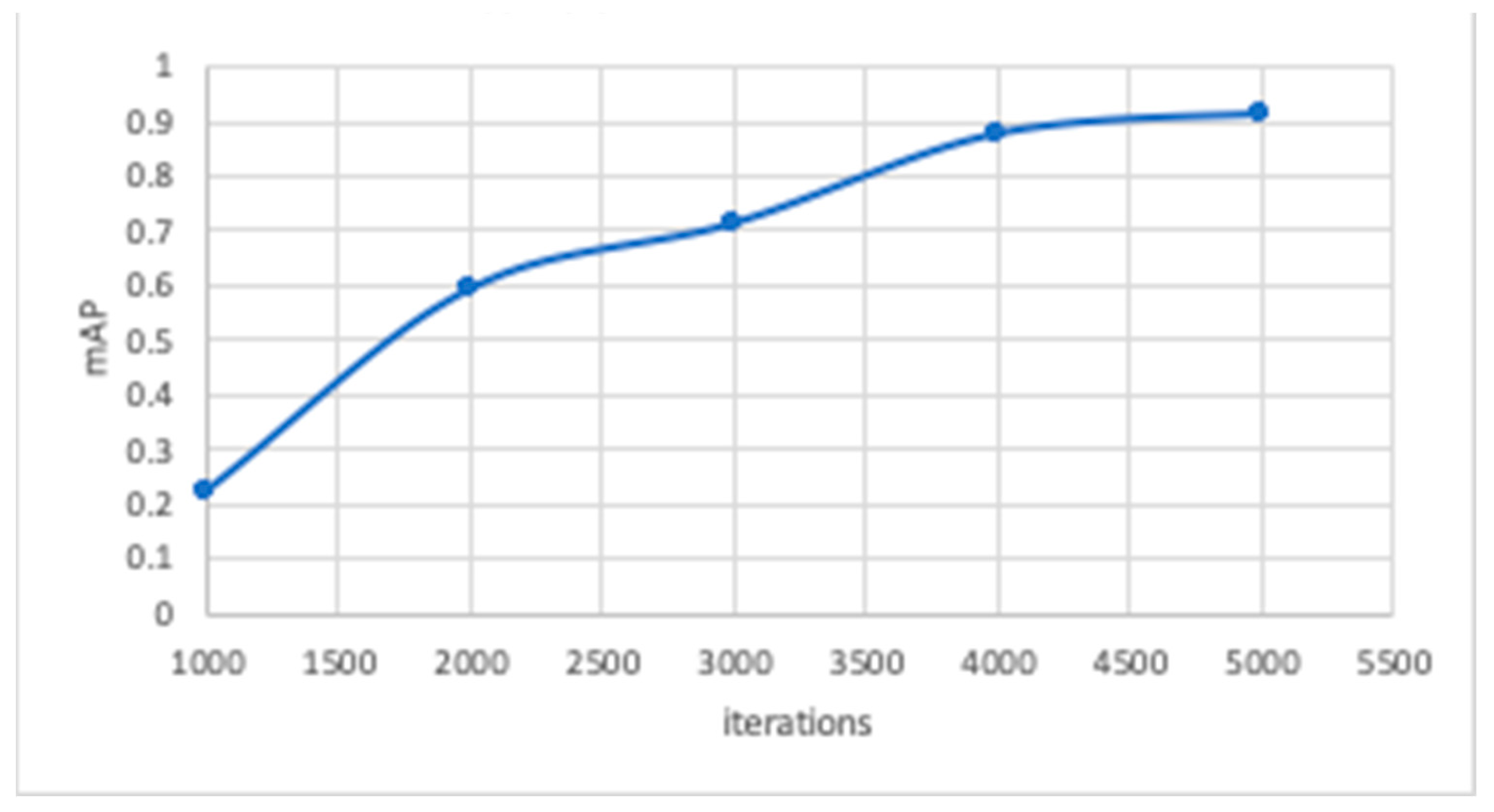
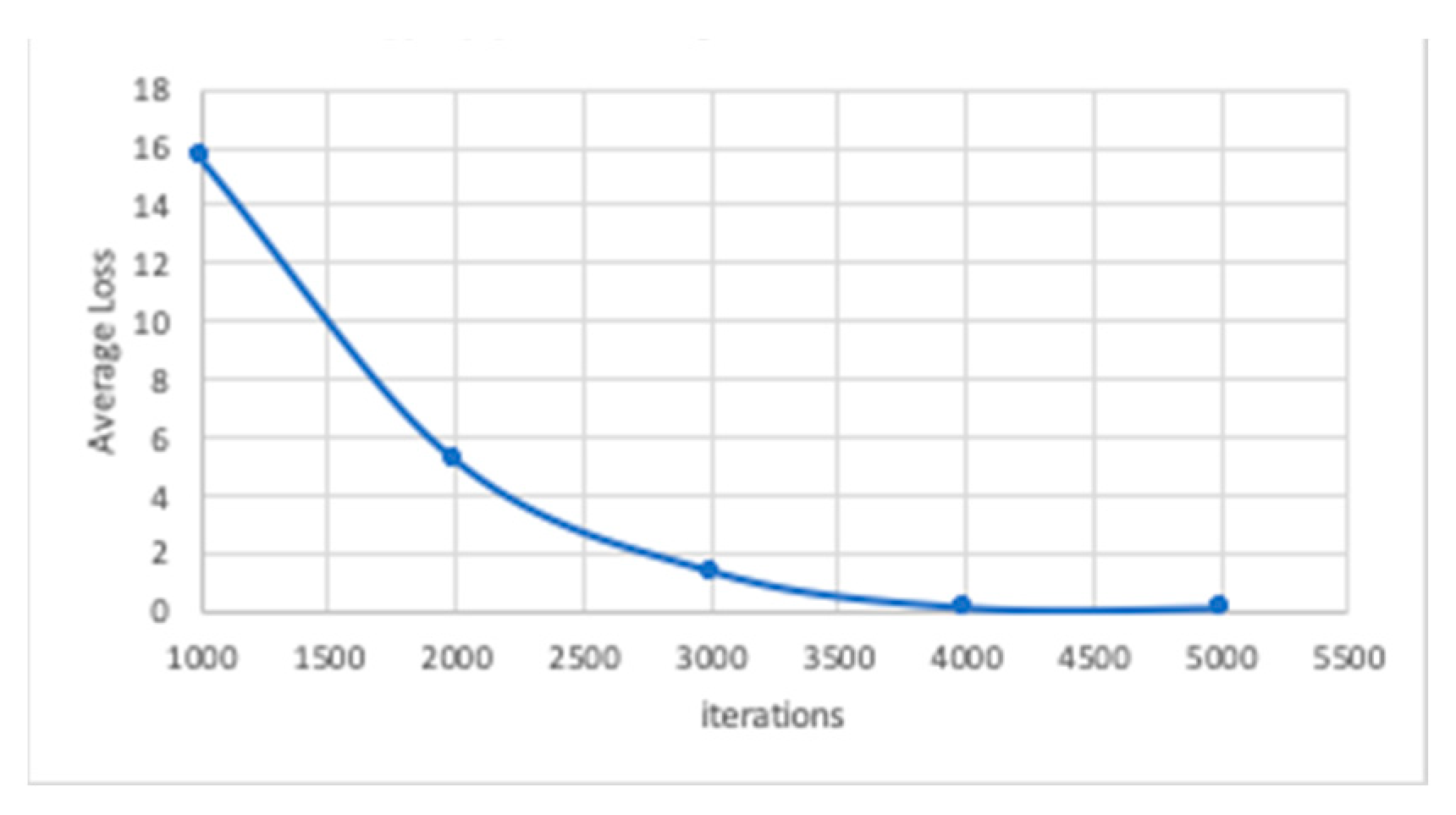
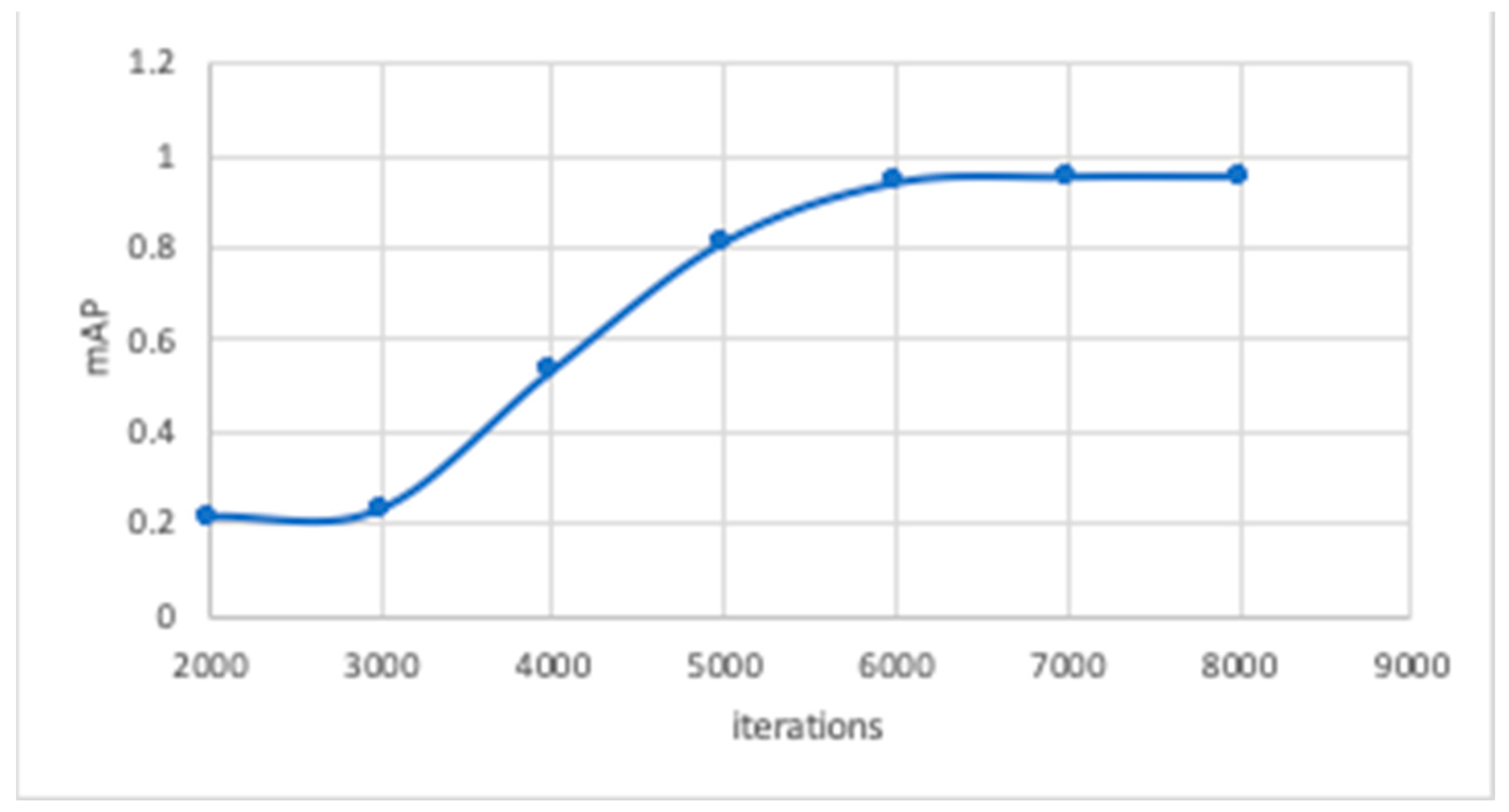
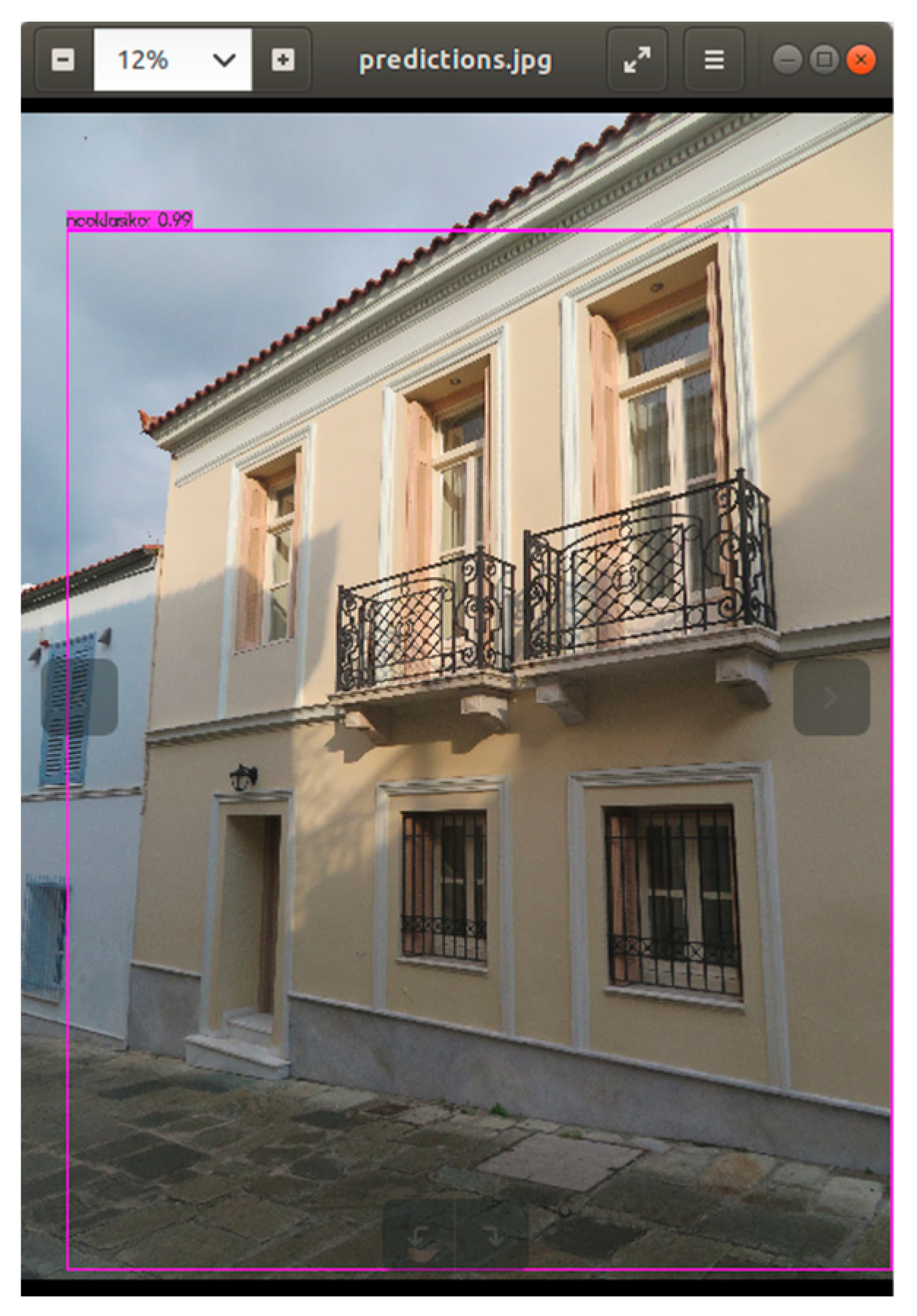
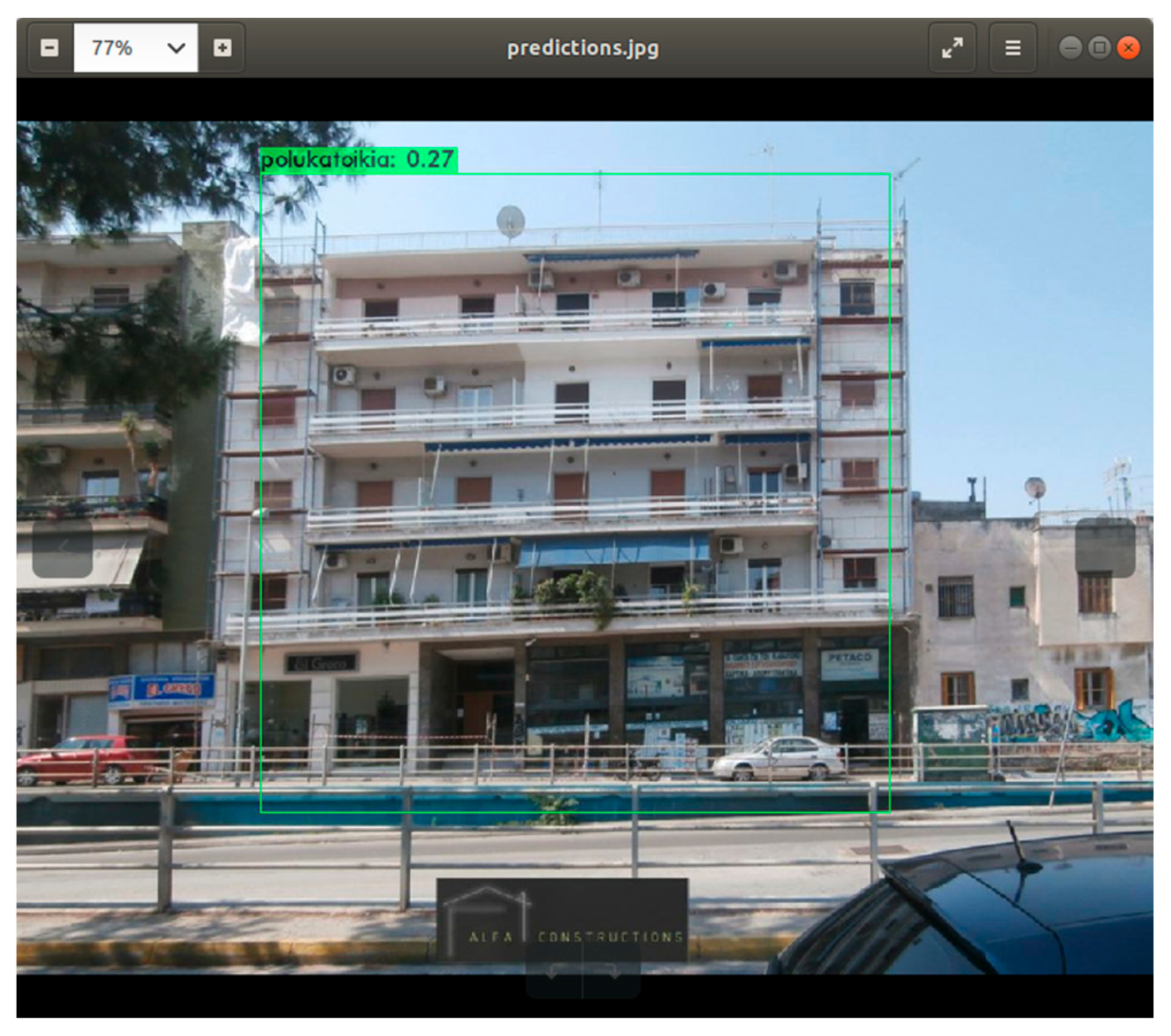

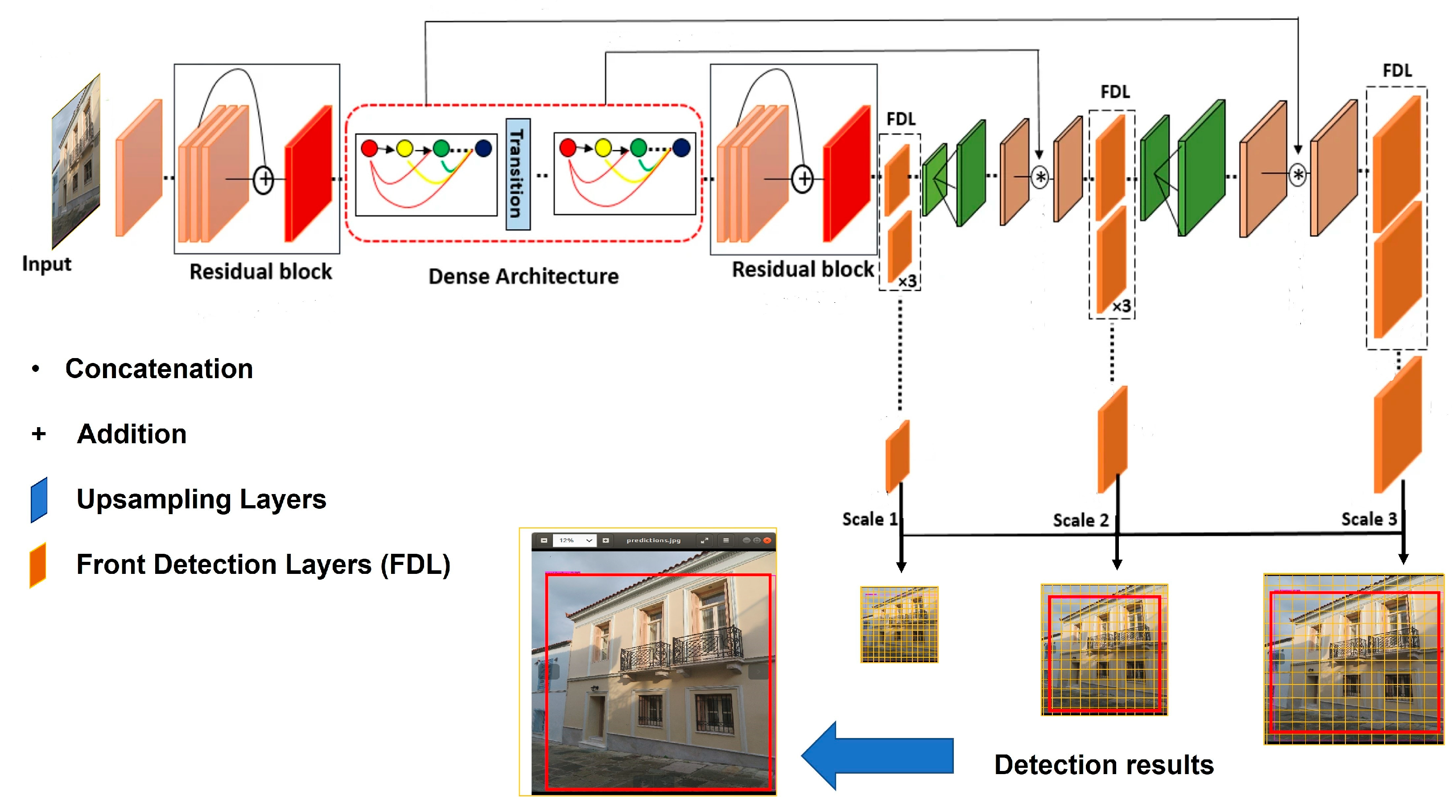
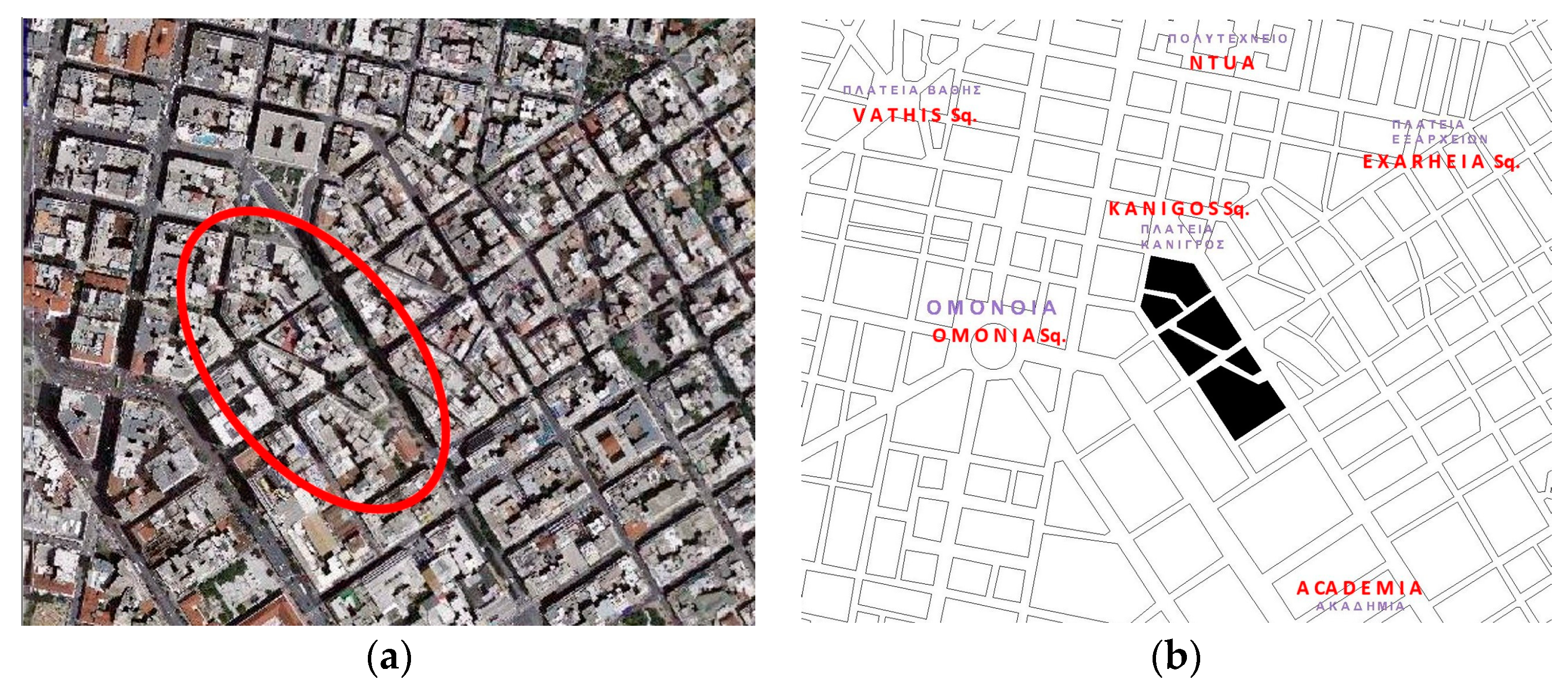
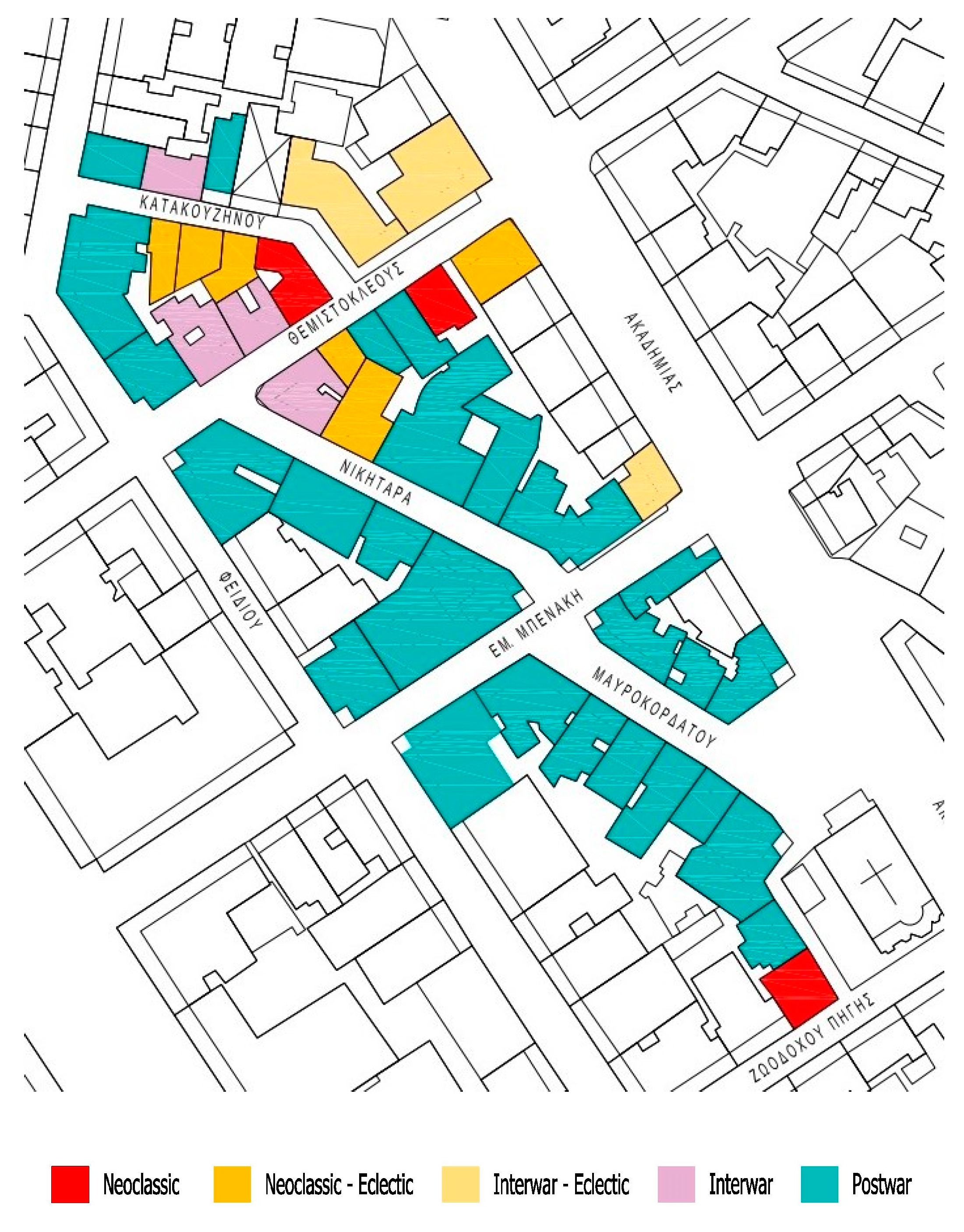
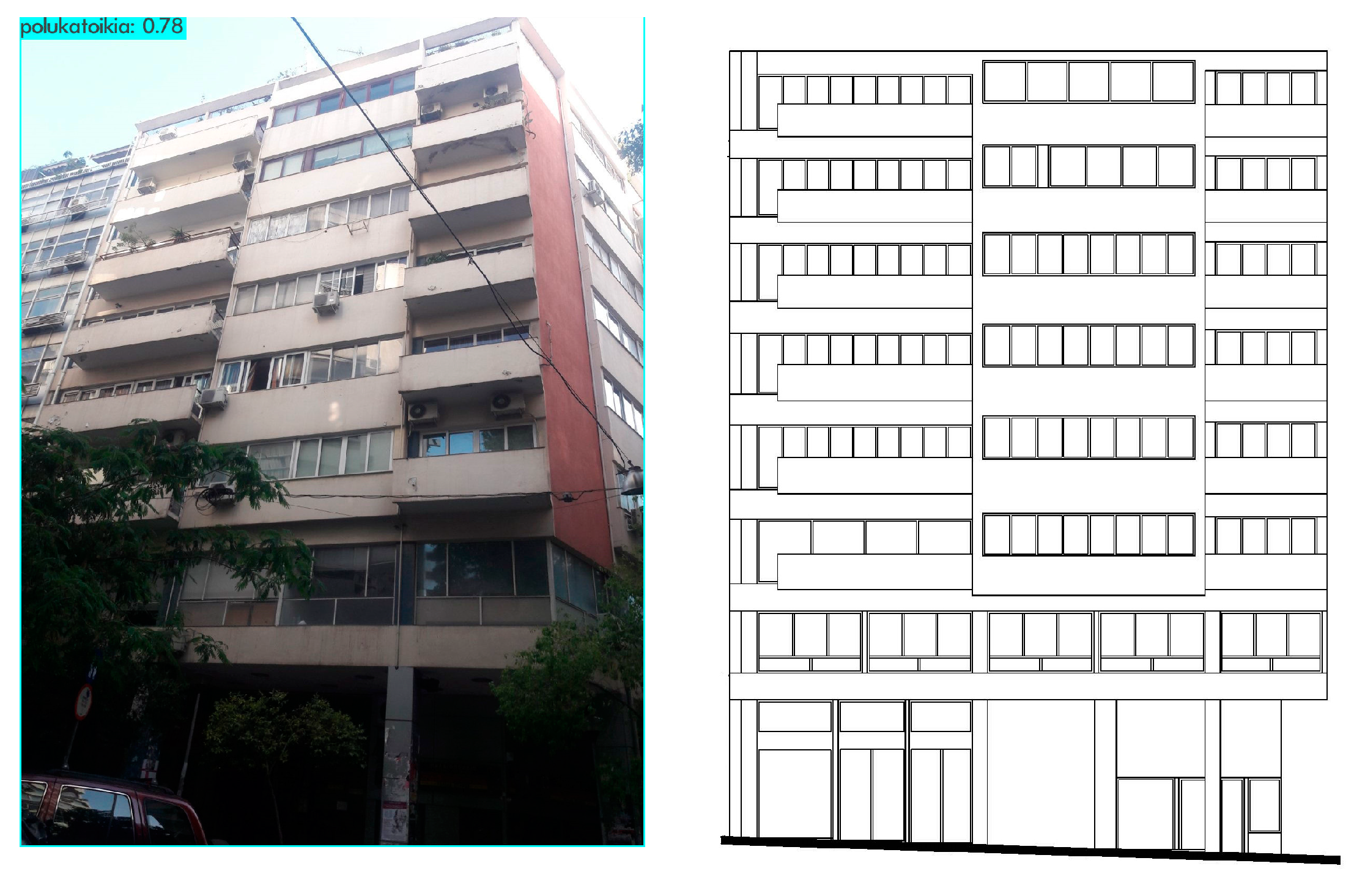
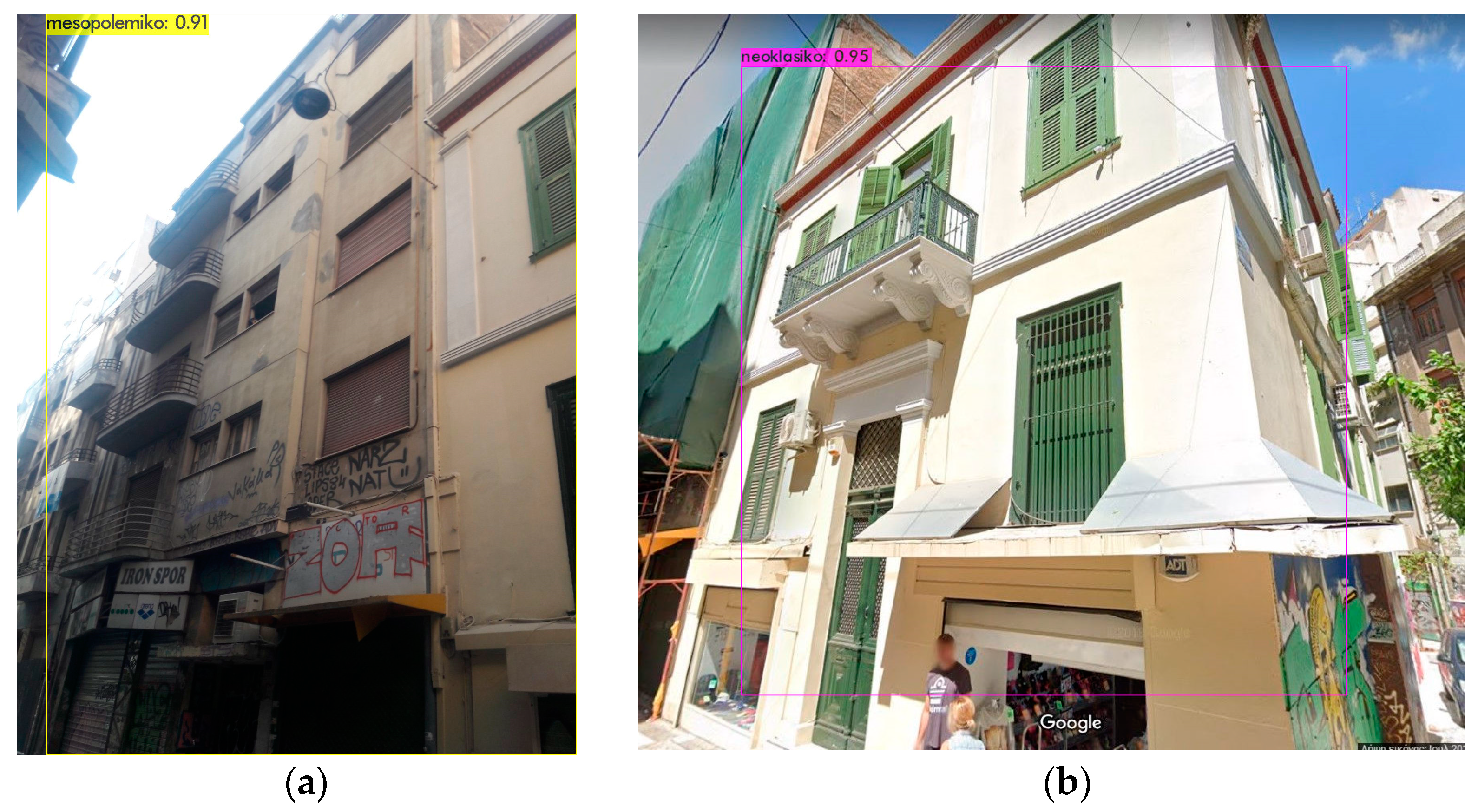
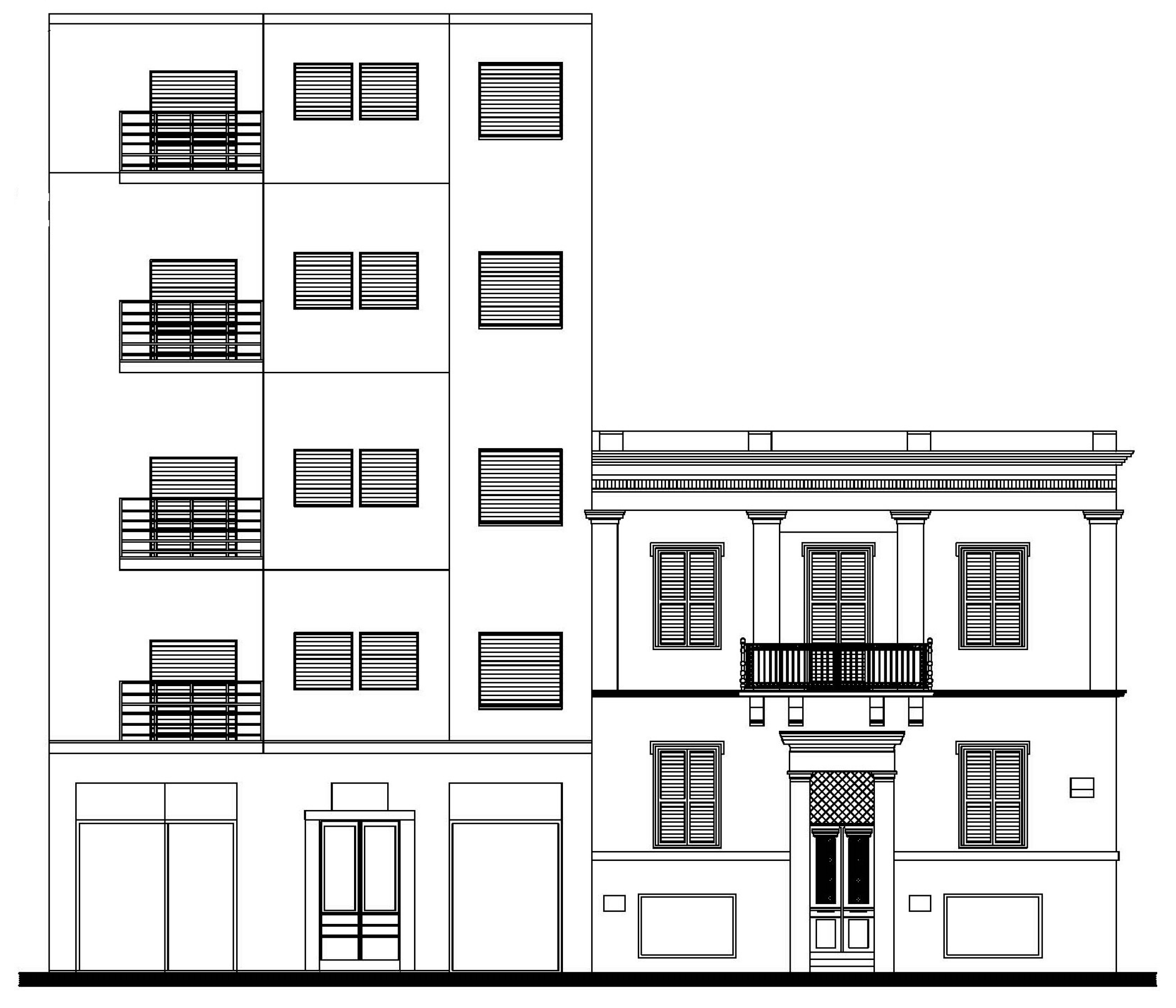

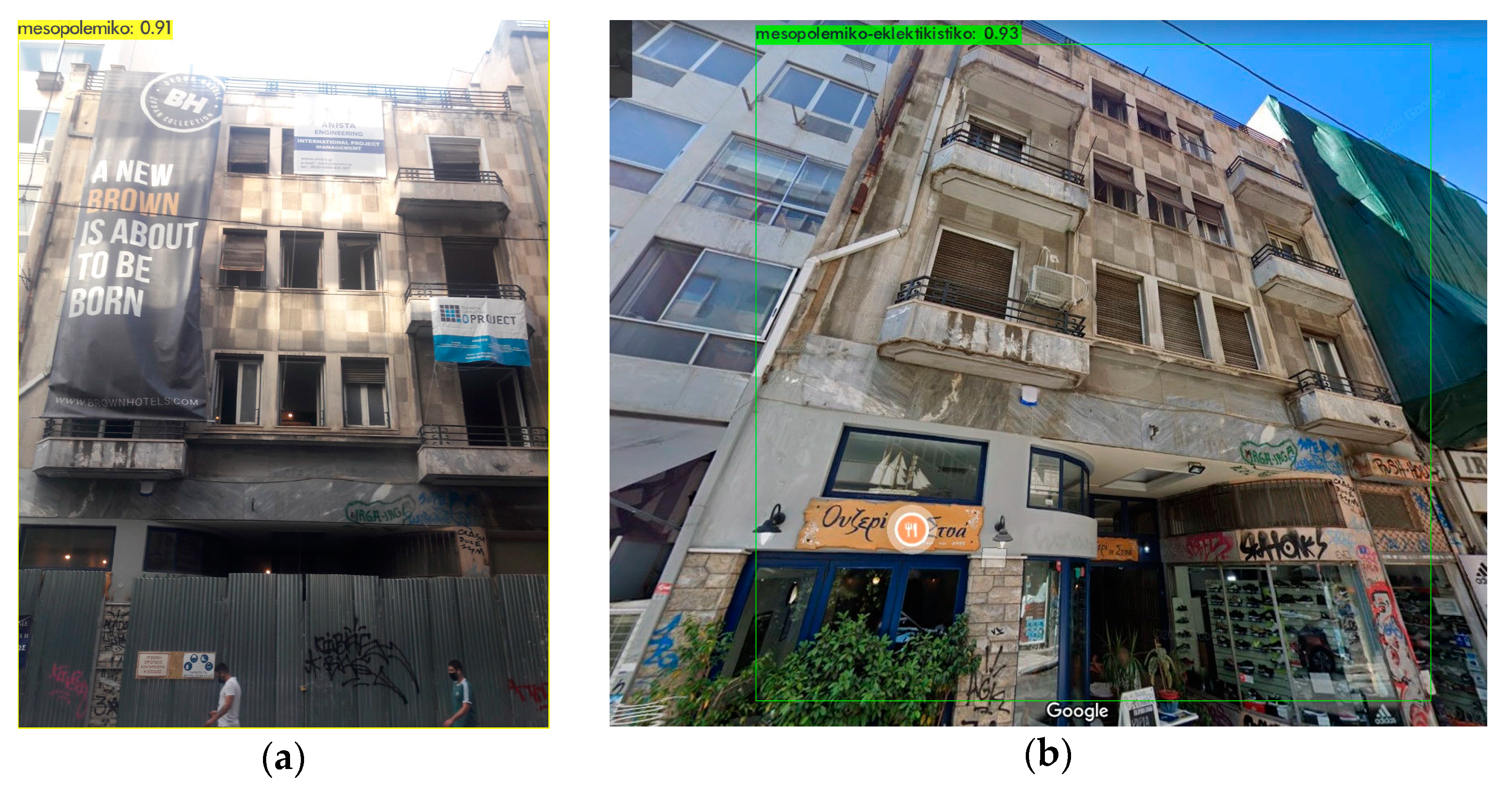
| Source: Social Media | Source: Camera | Source: Google Street View | Available Data Set Images |
|---|---|---|---|
| 2100 | 1850 | 2550 | 6500 |
| Layer | Filters | Size | Input | Output | |
|---|---|---|---|---|---|
| 1 | Conv | 64 | 3 × 3/2 | 608 × 608 × 64 | 304 × 304 × 64 |
| 2 | Conv | 64 | 1 × 1/1 | 304 × 304 × 64 | 304 × 304 × 64 |
| 3 | Route | 1 | 304 × 304 × 64 | ||
| 4 | Conv | 64 | 1 × 1/1 | 304 × 304 × 64 | 304 × 304 × 64 |
| 5 | Conv | 32 | 1 × 1/1 | 304 × 304 × 64 | 304 × 304 × 32 |
| 6 | Conv | 64 | 3 × 3/1 | 304 × 304 × 32 | 304 × 304 × 64 |
| 7 | Shortcut Layer: 4 | 304 × 304 × 64 | |||
| 8 | Conv | 64 | 1 x1/1 | 304 × 304 × 64 | 304 × 304 × 64 |
| 9 | Route | 8 2 | 304 × 304 × 128 | ||
| 10 | Conv | 64 | 1 × 1/1 | 304 × 304 × 128 | 304 × 304 × 64 |
| 11 | Conv | 128 | 3 × 3/2 | 304 × 304 × 64 | 152 × 152 × 128 |
| 12 | Conv | 64 | 1 × 1/1 | 152 × 152 × 128 | 152 × 152 × 64 |
| 13 | Route | 11 | 152 × 152 × 128 | ||
| 14 | Conv | 64 | 1 × 1/1 | 152 × 152 × 128 | 152 × 152 × 64 |
| 15 | Conv | 64 | 1 × 1/1 | 152 × 152 × 64 | 152 × 152 × 64 |
| 16 | Conv | 64 | 3 × 3/1 | 152 × 152 × 64 | 152 × 152 × 64 |
| 17 | Shortcut Layer: 14 | 152 × 152 × 64 | |||
| 18 | Conv | 64 | 1 × 1/1 | 152 × 152 × 64 | 152 × 152 × 64 |
| 19 | Conv | 64 | 3 × 3/1 | 152 × 152 × 64 | 152 × 152 × 64 |
| 20 | Shortcut Layer: 17 | 152 × 152 × 64 |
| Class | Images of Training | Validation Images | Sum |
|---|---|---|---|
| {door} | 136 | 34 | 170 |
| {balcony} | 202 | 48 | 250 |
| {window} | 176 | 44 | 220 |
| {corbels} | 466 | 116 | 582 |
| {door, window, balcony} | 782 | 195 | 977 |
| Class | Images of Training | Validation Images | Sum |
|---|---|---|---|
| {neoclassical, interwar} | 1307 | 327 | 1634 |
| {neoclassical, interwar, apartment building} | 2017 | 504 | 2521 |
| {neoclassical, neoclassical-eclectic, interwar, interwar-eclectic, apartment building} | 2912 | 728 | 3641 |
| Input resolution: | 416 × 416 pixels |
| Number of classes: | According to our experiment on the whole facade (not the architectural elements), our classes consisted of 2, 3, and 5 categories. |
| Number of detection layers: | 3 detection layers, each responsible for detecting objects at different scales. |
| Confidence threshold: | The parameter is set to 0.5, which indicates the minimum confidence score required for an object belonging to a class to be detected. |
| Non-max suppression threshold: | 0.45 |
| Learning rate: | 0.001 |
| Classes | Neoclassical | Interwar | Apartment Buildings | Neoclassical-Eclectic | Interwar-Eclectic | Data Set (Photos) |
|---|---|---|---|---|---|---|
| Interwar | 6 | 316 | 37 | 6 | 35 | 400 |
| Interwar-Eclectic | 3 | 18 | 4 | 7 | 68 | 100 |
| Classes | Neoclassical | Interwar | Apartment Buildings | Neoclassical-Eclectic | Interwar-Eclectic |
|---|---|---|---|---|---|
| Precision | 0.9461078 | n/a | n/a | n/a | 0.660194 |
| Recall | 0.79 | n/a | n/a | n/a | 0.68 |
| F1 | 0.8610354 | n/a | n/a | n/a | 0.669951 |
| Classes | Neoclassical | Interwar | Apartment Buildings | Neoclassical-Eclectic | Interwar-Eclectic | Data Set (Photos) |
|---|---|---|---|---|---|---|
| Neoclassical | 203 | 7 | 4 | 4 | 2 | 220 |
| Interwar | 2 | 179 | 21 | 3 | 25 | 230 |
| Apartment Buildings | 9 | 29 | 156 | 15 | 11 | 220 |
| Neoclassical-Eclectic | 42 | 10 | 8 | 139 | 11 | 210 |
| Interwar-Eclectic | 5 | 23 | 5 | 9 | 78 | 120 |
| Classes | Neoclassical | Interwar | Apartment Buildings | Neoclassical-Eclectic | Interwar-Eclectic |
|---|---|---|---|---|---|
| Precision | 0.777778 | 0.721774 | 0.804124 | 0.817647 | 0.614173 |
| Recall | 0.922727 | 0.778261 | 0.709091 | 0.661905 | 0.65 |
| F1 | 0.844075 | 0.748954 | 0.753623 | 0.731579 | 0.631579 |
| Classes | Neoclassical | Interwar | Apartment Buildings | Neoclassical-Eclectic | Interwar-Eclectic | Data Set (Photos) |
|---|---|---|---|---|---|---|
| Neoclassical | 5 | 0 | 0 | 1 | 0 | 6 |
| Interwar | 0 | 8 | 0 | 0 | 1 | 9 |
| Apartment Buildings | 4 | 5 | 58 | 10 | 13 | 80 |
| Neoclassical-Eclectic | 3 | 0 | 0 | 12 | 0 | 15 |
| Interwar-Eclectic | 0 | 0 | 0 | 2 | 8 | 10 |
| Classes | Neoclassical | Interwar | Apartment Buildings | Neoclassical-Eclectic | Interwar-Eclectic |
|---|---|---|---|---|---|
| Precision | 0.416667 | 0.615385 | 1 | 0.48 | 0.363636 |
| Recall | 0.833333 | 0.888889 | 0.644444 | 0.8 | 0.8 |
| F1 | 0.555556 | 0.727273 | 0.783784 | 0.6 | 0.5 |
| Class | Images of Training | Validation Images | Sum |
|---|---|---|---|
| {neoclassical, neoclassical-eclectic, interwar, interwar-eclectic, apartment building} | 2912 | 728 | 3641 |
| {interwar} (interwar-eclectic) | 500 | 500 | |
| {neoclassical, neoclassical-eclectic, interwar, interwar-eclectic, apartment building} | 1000 | 1000 | |
| Total set of images | 5141 | ||
Disclaimer/Publisher’s Note: The statements, opinions and data contained in all publications are solely those of the individual author(s) and contributor(s) and not of MDPI and/or the editor(s). MDPI and/or the editor(s) disclaim responsibility for any injury to people or property resulting from any ideas, methods, instructions or products referred to in the content. |
© 2023 by the authors. Licensee MDPI, Basel, Switzerland. This article is an open access article distributed under the terms and conditions of the Creative Commons Attribution (CC BY) license (https://creativecommons.org/licenses/by/4.0/).
Share and Cite
Siountri, K.; Anagnostopoulos, C.-N. The Classification of Cultural Heritage Buildings in Athens Using Deep Learning Techniques. Heritage 2023, 6, 3673-3705. https://doi.org/10.3390/heritage6040195
Siountri K, Anagnostopoulos C-N. The Classification of Cultural Heritage Buildings in Athens Using Deep Learning Techniques. Heritage. 2023; 6(4):3673-3705. https://doi.org/10.3390/heritage6040195
Chicago/Turabian StyleSiountri, Konstantina, and Christos-Nikolaos Anagnostopoulos. 2023. "The Classification of Cultural Heritage Buildings in Athens Using Deep Learning Techniques" Heritage 6, no. 4: 3673-3705. https://doi.org/10.3390/heritage6040195
APA StyleSiountri, K., & Anagnostopoulos, C.-N. (2023). The Classification of Cultural Heritage Buildings in Athens Using Deep Learning Techniques. Heritage, 6(4), 3673-3705. https://doi.org/10.3390/heritage6040195







